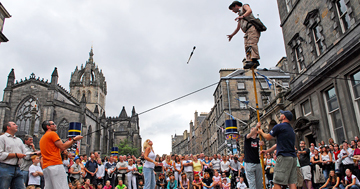Dance: The World’s Largest Performing Arts Festival Turns 70: A Guide to Edinburgh Fests
By Justine Bayod Espoz
arttimesjournal July 4, 2017
 Street Performers at 2017 Edinburgh Fringe |
In 1947, the Edinburgh International Festival premiered in the Scottish capital with the goal of reviving Europe’s cultural landscape after the devastation of WWII. The festival continues in operation to this day, presenting some of the world’s most lauded companies and artists. However, it was on the heels of this endeavor that another even more important artistic phenomenon was born.
The Edinburgh Fringe arose from what could be described as a small but inspiring act of rebellion. Eight theatre companies that were not invited to participate in the official program of the International Fest decided to show up anyway and perform on the “fringe” of the festival. Seven decades later, those initial eight companies have ballooned to over 2,000. Makeshift performance venues sprout up on every corner of the city’s public space throughout the month of August. The sheer volume of performances make the Fringe the largest performing arts festival in the world, and its unquestionable success has spurred the ongoing foundation of fringe festivals in cities and towns across the globe.
The Edinburgh Fringe should make everyone’s bucket list. It’s jovial artistic mayhem in a gorgeous fairytale city erected in grey stone, and the choices for entertainment are limitless. See standup comedy one day, dance the next, theatre the day after and cabaret the day after that.
The Fringe’s massive scale makes navigating the festival daunting, so it’s good to know your venues. Everyone has his or her favorites, but a handful of venues are universally known amongst Fringe-goers for their excellence in specific genres of performance.
For the dance aficionados there’s no venue like Dance Base, which converts its two dance studios into intimate theatres for the duration of the Fringe. Their curated program strives to showcase dance of the highest quality but also takes plurality of style very seriously. Every year is sure to bring a fantastic assortment of international companies performing contemporary, classical and traditional/folkloric dance. The venue also gets an additional thumbs up for including inclusive productions – those featuring physically and mentally challenged dancers – in a venue that is handicap accessible.
For thespians and dramatists, the Traverse is a home away from home in Edinburgh. Although it functions as a theatre presenting new writing throughout the year, during the month of August, it puts on original plays morning, noon and into the wee hours of the night. The production value is high, and the writing superb, with almost every one of the plays presented snagging coveted Fringe awards. But the strength of the Traverse’s Fringe programming rests in the variety of voices represented. Although there is a strong contingent of new Scottish plays, there’s also a healthy international showing, and the stories recounted represent diverse communities and cultures.
Comedy is by far the performance genre in highest demand and greatest volume at the Fringe. From improv to sketch comedy to standup, almost every venue presents some sort of comedy production, and the venue is rarely a determining factor of the comic’s quality. However, it does seem that a lot of the bigger names and the most innovative acts tend to gravitate to the Pleasance and the Gilded Balloon. Both are massive, multi-complex venues that also host multiple bars and ticketed dance parties so that patrons can come for the comedy, stay for the drinks and party the night away.
For visitors who want to see some of Edinburgh’s most spectacular performance halls, it’s important not to forget that the International Festival runs the same dates as the Fringe, also turning 70 in 2017. Listen to the world’s most lauded symphonies at the cavernous Usher Hall. Sink back into the seats at the Festival Theatre transfixed by the sound and sight of world-class opera and ballet, and play spectator to theatre master works by international playwrights of today and yesterday at the Lyceum and King’s Theatres.
For the best possible festival experience, it’s essential to get a good mix of fringe and consecrated genres and visit both improvised venues and ornate playhouses.
